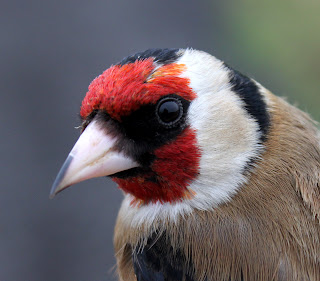This morning began with bright sun and a south westerly breeze, conditions which made me optimistic about a gentle walk at Pilling. Within an hour the solid grey clouds of late rolled back in and it was a fairly uneventful few hours although other signs of spring continue with birds in song and display.
The Hi-fly fields continue to hold good numbers of waders, mainly Lapwing, Redshank and Golden Plover, with sometimes Dunlin, so it’s always a good idea to stop and work through the flock for something different. Not today, just 120 Lapwing, 40+ Redshank, 90 Golden Plover and 8 Oystercatcher, although it was interesting that as the flock of Lapwings both fed and roosted on the well-muddied stubble, just away from the main gathering a few lone males performed their noisy, tumbling displays. In the distant stubble I could see several Skylarks, a few breaking off from searching through the mud-covered stalks to indulge in aerial chases.


When I later walked the sea wall I saw both Redshanks and Oystercatchers in territorial mode, with 4 singing Skylarks at appropriate distances apart, spots remarkably close to last year’s eventual nests.
By the time I got to Lane Ends the 100% blue sky was replaced by full grey cloud but undeterred I checked the pools, listened for Chiffchaffs, and then walked the wall in search of Wheatears or Meadow Pipits.
The pools held 2 Tufted Duck, 2 Goldeneye, 2 Little Grebe and 2 Little Egret, with my money firmly on Tufted Ducks and Little Grebes for breeding success and a small side bet on Little Egret – eventually. Along the sea wall the 30 or so pipits of Monday had moved on, now all I found were 6 at Pilling Water with a lone Pied Wagtail and 2 more Little Egret. The Greenshank flushed noisily from the pool, closely followed by the now silent Green Sandpiper, and is it my imagination but are Green Sandpipers more vocal in the autumn?

And now news from Will’s garden where unlike this time last year, the bird count is virtually zero. However Will did receive news of a Swallow Y279264 he ringed in the garden shed last year, one of a nest of 3 youngsters ringed on 8th September 2011. On 12th October, this young bird was recaptured at Icklesham, East Sussex before heading rapidly south over the English Channel then through France and Spain towards its eventual destination somewhere in the south of the African continent.


The ringing group had news of another bird recaptured at Icklesham, this a Lesser Redpoll L583835 ringed at Rossall School, Fleetwood on spring passage 10th April 2011 and later recaptured at Icklesham on 19th October 2011. Lesser Redpolls heading to southern UK may winter there, but equally many individuals fly on to Belgium, the Netherlands and France.
















































.jpg)












